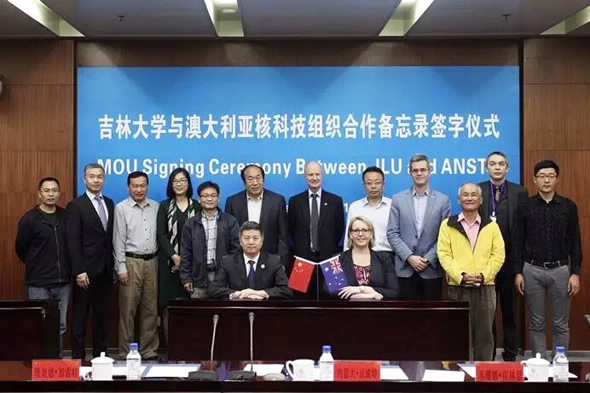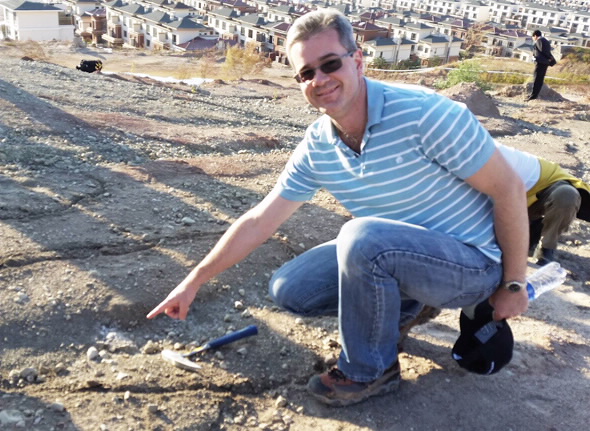ANSTO has signed a Memorandum of Understanding with Jilin University in China that will enable the two organisations to share expertise and facilities to study the evolution of dinosaurs.

Suzanne Hollins, Head of Research, Richard Garrett, Manager Industry & External Engagement, Joseph Bevitt, Manager of the Research Office and an experienced neutron beam instrument scientist who studies dinosaur fossils and Anton Maksimenko, an instrument scientist from the Australian Synchrotron, travelled to Changchun China to sign the agreement and meet with representatives of Dinosaur Evolution Research Center at the University.
The Chinese centre aims to become a world-class research institute of ancient vertebrates using its extensive collection of fossils from the Jilin University Museum.
Prof Sun Youhong, Vice President, Jilin University, who signed the agreement, said the Centre was enthusiastic about access to ANSTO’s advanced scientific technology to study palaeontological finds and future interdisciplinary collaboration.
The university museum has the most complete fossil record of the northeast region of China, including the first dinosaur fossilised skeleton, Yinlong, which was unearthed in Jilin province.
Many of the fossils come from the Yixian Formation, which is believed to date from the Late Jurassic-Early Crustaceous period.
We saw the holotype Changchunsaurus, a small herbivorous ornithopod dinosaur from Early Cretaceous deposits of Gongzhuling, Jilin, China.
It was the first dinosaur genus named from Jilin, and will be one of the first specimens planned for research at ANSTO,” said Bevitt.
“After the formalities, our colleagues, who included Centre Director Huang Taichi, pulled out their laptops, gathered around and started comparing their latest dinosaur data,” said Bevitt.
 |
| A small herbivorous dinosaur, Changchunsaurus, fossil from Jilin, China |
“ANSTO’s neutron and X-ray instruments are very useful in looking into the bone structure of fossils non-invasively to reveal new insights into dinosaur evolution, growth and lifestyle. Importantly, our researchers have demonstrated experience in handling these priceless specimens,” said Bevitt.
Bevitt has examined a large number of dinosaur and mammalian fossils from Australia, China, the USA and Mongolia. Read more.
While in Changchun, Bevitt and Hollins were invited by colleagues from the Dinosaur Evolution Research Center to travel to a newly discovered, Early Cretaceous (146 – 100 million years ago) dinosaur dig site at Yanji, Jilin Province, where large dinosaur bones were plainly visible on the surface.
 |
| Joseph Bevitt points out fossils plainly visible on the surface at a dinosaur dig site. |
I had the honour of holding the 130-million year old dinosaur skull of Jeholosaurus, a small herbivorous ornithopod dinosaur from the Early Cretaceous Period. It was found in 2000 at Lujiatun near Beipiao City, Liaoning Province. It was beautiful, delicate and amazingly birdlike.”
The first feathered dinosaur fossil was also unearthed in Liaoning Province, northern China in 1996–the Sinosauropteryx. The finding confirmed that some dinosaurs were feathered and birdlike.
According to a media report on CNN which profiled the work of palaeontologist Xu Xing, China's reputation as a paleontological powerhouse is largely thanks to one fossil site–in Liaoning in northern China.
Here, 100 million years ago, ago dinosaurs died en masse, caught up in a massive series of volcanic eruptions, leaving behind a treasure trove of exquisitely preserved fossils with a level of detail seen at few other sites.
Some of the fossils of the feathered dinosaurs are so well preserved that researchers have been able to capture information from "melansomes"–tiny structures buried within feathers that give them colour.


